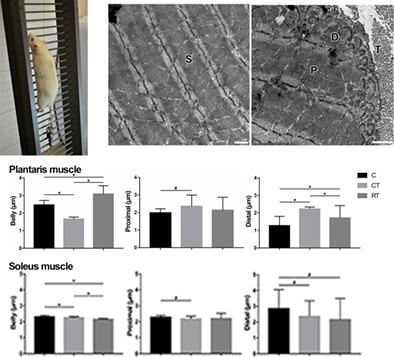当前位置:
X-MOL 学术
›
Microsc. Res. Tech.
›
论文详情
Our official English website, www.x-mol.net, welcomes your
feedback! (Note: you will need to create a separate account there.)
Repercussions on sarcomeres of the myotendinous junction and the myofibrillar type adaptations in response to different trainings on vertical ladder.
Microscopy Research and Technique ( IF 2.0 ) Pub Date : 2020-06-04 , DOI: 10.1002/jemt.23510 Lara Caetano Rocha 1 , Jurandyr Pimentel Neto 1 , Jossei Soares de Sant'Ana 1 , Carolina Dos Santos Jacob 1 , Gabriela Klein Barbosa 1 , Walter Krause Neto 2 , Ii-Sei Watanabe 3 , Adriano Polican Ciena 1
Microscopy Research and Technique ( IF 2.0 ) Pub Date : 2020-06-04 , DOI: 10.1002/jemt.23510 Lara Caetano Rocha 1 , Jurandyr Pimentel Neto 1 , Jossei Soares de Sant'Ana 1 , Carolina Dos Santos Jacob 1 , Gabriela Klein Barbosa 1 , Walter Krause Neto 2 , Ii-Sei Watanabe 3 , Adriano Polican Ciena 1
Affiliation

|
The myofibrillary types establish to the skeletal muscle functional and adaptive properties that influence the sarcomeric arrangement during muscle contraction and may have repercussions on an important related force transmission region of the locomotor apparatus, the myotendinous junction (MTJ). This study aimed to describe changes in myofibrillary type and sarcomeric lengths in the belly muscle and MTJ of the soleus and plantaris muscles associated with training protocols in vertical ladder. Thirty adults male Wistar rats were divided into three groups (n = 10): Control (CTR), No‐load Training (NLT), and Load Training (LT). Morphoquantitative analysis of different fibers types and sarcomere lengths were performed in distinct regions of plantaris and soleus muscles. In the plantaris muscle with both trainings, there was an increase in the cross‐sectional area (CSA) in Type I and II fibers (p < .0001) while sarcomeric lengths revealed greater lengths in the proximal and distal sarcomeres of NLT, although in the LT we found greater lengths in the belly and MTJ sarcomeres. The soleus muscle showed an increase in CSA muscle fiber only in the NLT (p < .0001) and revealed alterations in belly and MTJ sarcomere lengths with training. We concluded that plantaris muscle has an adaptive effect directly associated with training load, with hypertrophy in both trainings and sarcomere length inverse from belly and MTJ, in LT associated with increased force generation and transmission at the MTJ, although soleus muscle has a lower adaptive response to training stimuli with variation in the belly and distal sarcomere of the MTJ.
中文翻译:

对肌腱连接处的肌节和肌原纤维类型适应的影响,以响应垂直梯子上的不同训练。
肌原纤维类型对骨骼肌的功能和适应性产生影响,这些特性影响肌肉收缩期间的肌节排列,并且可能对运动器官的重要相关力传递区域——肌腱连接处 (MTJ) 产生影响。本研究旨在描述与垂直阶梯训练方案相关的腹肌和比目鱼肌和跖肌 MTJ 的肌原纤维类型和肌节长度的变化。将三十只成年雄性 Wistar 大鼠分为三组(n= 10):控制 (CTR)、无负荷训练 (NLT) 和负荷训练 (LT)。在足底肌和比目鱼肌的不同区域进行了不同纤维类型和肌节长度的形态定量分析。在两种训练的跖肌中,I 型和 II 型纤维的横截面积 (CSA) 增加(p < .0001),而 NLT 近端和远端肌节的肌节长度显示更长,尽管在LT 我们发现腹部和 MTJ 肌节的长度更长。比目鱼肌仅在 NLT 中表现出 CSA 肌纤维的增加(p< .0001) 并揭示了训练后腹部和 MTJ 肌节长度的变化。我们得出结论,足底肌具有与训练负荷直接相关的适应性效应,训练中的肥大和肌节长度与腹部和 MTJ 成反比,在 LT 中与 MTJ 的力生成和传递增加相关,尽管比目鱼肌的适应性反应较低训练 MTJ 腹部和远端肌节变化的刺激。
更新日期:2020-06-04
中文翻译:

对肌腱连接处的肌节和肌原纤维类型适应的影响,以响应垂直梯子上的不同训练。
肌原纤维类型对骨骼肌的功能和适应性产生影响,这些特性影响肌肉收缩期间的肌节排列,并且可能对运动器官的重要相关力传递区域——肌腱连接处 (MTJ) 产生影响。本研究旨在描述与垂直阶梯训练方案相关的腹肌和比目鱼肌和跖肌 MTJ 的肌原纤维类型和肌节长度的变化。将三十只成年雄性 Wistar 大鼠分为三组(n= 10):控制 (CTR)、无负荷训练 (NLT) 和负荷训练 (LT)。在足底肌和比目鱼肌的不同区域进行了不同纤维类型和肌节长度的形态定量分析。在两种训练的跖肌中,I 型和 II 型纤维的横截面积 (CSA) 增加(p < .0001),而 NLT 近端和远端肌节的肌节长度显示更长,尽管在LT 我们发现腹部和 MTJ 肌节的长度更长。比目鱼肌仅在 NLT 中表现出 CSA 肌纤维的增加(p< .0001) 并揭示了训练后腹部和 MTJ 肌节长度的变化。我们得出结论,足底肌具有与训练负荷直接相关的适应性效应,训练中的肥大和肌节长度与腹部和 MTJ 成反比,在 LT 中与 MTJ 的力生成和传递增加相关,尽管比目鱼肌的适应性反应较低训练 MTJ 腹部和远端肌节变化的刺激。











































 京公网安备 11010802027423号
京公网安备 11010802027423号